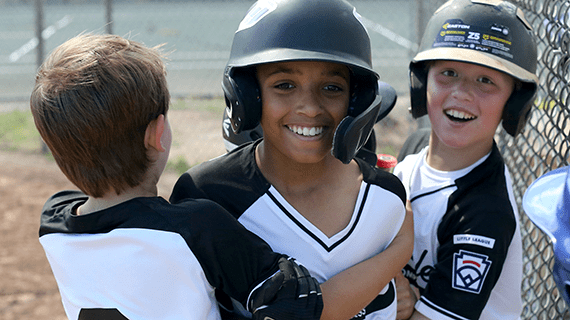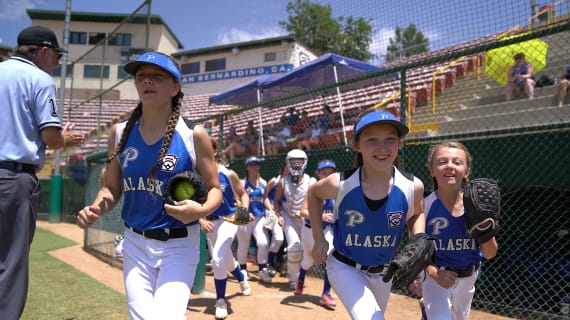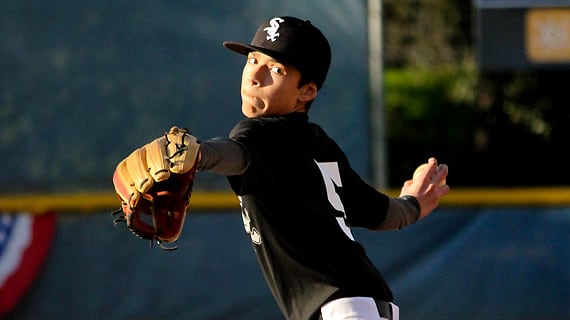Little League® has always placed safety as a top priority, and is continually striving to provide children with healthy and safe baseball and softball opportunities. For more than a decade, the Little League program has been at the forefront of promoting arm safety for youth pitchers. As we continue to work to make baseball a safe, fun sport for all children, Little League is proudly supporting the efforts of Major League Baseball and USA Baseball through the Pitch Smart campaign.
About Pitch Count
The eligibility of a player to pitch in a Little League® Baseball, Softball, or Challenger game is governed by a tiered pitch count that is tied to the number of pitches thrown in a game. The pitch count determines how many days of rest are required before said player may pitch again.

As the Official Pitch Count Technology of Little League®, GameChanger provides powerful, free scorekeeping tools that can help you track pitch counts for your Little League baseball and softball teams.
Learn More About the GameChanger App


Baseball Pitch Count BY League Age
Baseball Pitch Count BY Days Rest Thresholds
REGULATION VI – PITCHERS
Regular Season Baseball Pitching Rules
(a) Any player on a regular season team may pitch.
Exception: Any player who has played the position of catcher in four (4) or more innings in a game is not eligible to pitch on that calendar day.
A player who played the position of catcher for three (3) innings or less, moves to the pitcher position, and delivers 21 pitches or more (15- and 16-year-olds: 31 pitches or more) in the same day, may not return to the catcher position on that calendar day. EXCEPTION: If the pitcher reaches the 20-pitch limit (15- and 16-year-olds: 30-pitch limit) while facing a batter, the pitcher may continue to pitch, and maintain their eligibility to return to the catcher position, until any one of the following conditions occur: (1) that batter reaches base; (2) that batter is retired; (3) the third out is made to complete the half-inning or the game; or (4) the pitcher is removed from the mound prior to the batter completing his/her at-bat.
(b) A pitcher once removed from the mound cannot return as a pitcher.
Intermediate (50-70) Division, Junior League, and Senior League only: A pitcher remaining on defense in the game, but moving to a different defensive position, can return as a pitcher anytime in the remainder of the game, but only once per game.
(c) The manager must remove the pitcher when said pitcher reaches the limit for his/her age group as noted below, but the pitcher may remain in the game at another position:
| LEAGUE AGE | |
| AGE | PITCHES PER DAY |
| 6-8 | 50 Pitches |
| 9-10 | 75 Pitches |
| 11-12 | 85 Pitches |
| 13-16 | 95 Pitches |
Exception: If a pitcher reaches the limit imposed in Regulation VI(c) for his/her league age while facing a batter, the pitcher may continue to pitch until any one of the following conditions occurs:
- The batter reaches base;
- The batter is put out;
- The third out is made to complete the half-inning of the game;
- The pitcher is removed from the mound prior to the batter completing his/her at bat.
NOTE: If a pitcher reaches 40 pitches while facing a batter, the pitcher may continue to pitch, and maintain their eligibility to play the position of catcher for the remainder of that day, until any one of the following conditions occurs:(1) that batter reaches base; (2) that batter is retired; (3) the third out is made to complete the half inning or the game; or (4) the pitcher is removed from the mound prior to the batter completing his/her at-bat. The pitcher would be allowed to play the catcher position provided that pitcher is moved, removed, or the game is completed before delivering a pitch to another batter. If a player delivers 41 or more pitches, and is not covered under the threshold exception, the player may not play the position of catcher for the remainder of that day.
(d) Pitchers league age 14 and under must adhere to the following rest requirements:
- If a player pitches 66 or more pitches in a day, four (4) calendar days of rest must be observed.
- If a player pitches 51-65 pitches in a day, three (3) calendar days of rest must be observed.
- If a player pitches 36-50 pitches in a day, two (2) calendar days of rest must be observed.
- If a player pitches 21-35 pitches in a day, one (1) calendar day of rest must be observed.
- If a player pitches 1-20 pitches in a day, no (0) calendar day of rest is required.
NOTE 1: Under no circumstance shall a player pitch in three (3) consecutive days.
NOTE 2: A pitcher’s pitch count for the purposes of day(s) rest threshold is determined by the first pitch thrown to a batter. The pitcher may not start a new batter once the limit imposed in Regulation VI(c) has been met.
Pitchers league age 15-16 must adhere to the following rest requirements:
- If a player pitches 76 or more pitches in a day, four (4) calendar days of rest must be observed.
- If a player pitches 61-75 pitches in a day, three (3) calendar days of rest must be observed.
- If a player pitches 46-60 pitches in a day, two (2) calendar days of rest must be observed.
- If a player pitches 31-45 pitches in a day, one (1) calendar day of rest must be observed.
- If a player pitches 1-30 pitches in a day, no (0) calendar day of rest is required.
NOTE 1: Under no circumstance shall a player pitch in three (3) consecutive days.
NOTE 2: A pitcher’s pitch count for the purposes of day(s) rest threshold is determined by the first pitch thrown to a batter. The pitcher may not start a new batter once the limit imposed in Regulation VI(c) has been met.
(e) Each league must designate the scorekeeper or another game official as the official pitch count recorder.
(f) The pitch count recorder must provide the current pitch count for any pitcher when requested by either manager or any umpire. However, the manager is responsible for knowing when his/her pitcher must be removed.
(g) The official pitch count recorder should inform the Umpire-in-Chief when a pitcher has delivered his/her maximum limit of pitches for the game, as noted in Regulation VI(c). The Umpire-in-Chief will inform the pitcher’s manager that the pitcher must be removed in accordance with Regulation VI(c). However, the failure by the pitch count recorder to notify the Umpire-in-Chief, and/or the failure of the Umpire-in-Chief to notify the manager, does not relieve the manager of his/her responsibility to remove a pitcher when that pitcher is no longer eligible.
(h) Violation of any section of this regulation can result in protest of the game in which it occurs. Protest shall be made in accordance with Playing Rule 4.19.
(j) Minor League: A player who has attained the league age of twelve (12) is not eligible to pitch. (See Regulation V – Selection of Players)
Junior League: A local league Board may prohibit 15-year-olds from pitching within the Junior Division.
(k) Pitching in more than one game in a day:
Minor League, Little League (Majors), and Intermediate (50-70) Division – A player may not pitch in more than one game in a day;
Junior League and Senior League – A player may be used as a pitcher in up to two games in a day. EXCEPTION: A 12-year-old playing in the Junior and/or Senior Division is not eligible to pitch in two games in a day. NOTE: If a pitcher reaches 30 pitches while facing a batter in the first game, the pitcher may continue to pitch, and maintain their eligibility to pitch in the second game on that day, until any one of the following conditions occurs: (1) that batter reaches base; (2) that batter is retired; (3) the third out is made to complete the half-inning or the game; or (4) the pitcher is removed from the mound prior to the batter completing his/her at-bat. The pitcher would be allowed to pitch in a second game provided that pitcher is moved, removed, or the game is completed before delivering a pitch to another batter. If a player delivers 31 or more pitches in the first game, and is not covered under the threshold exception, the player may not pitch in the second game that day);
NOTES:
- The withdrawal of an ineligible pitcher after that pitcher is announced, or after a warm-up pitch is delivered, but before that player has pitched a ball to a batter, shall not be considered a violation. Little League officials are urged to take precautions to prevent protests. When a protest situation is imminent, the potential offender should be notified immediately.
Approved Ruling: Minor League and Little League (Majors): When warming up, if a pitcher is discovered to be ineligible, he/she must be removed and the previous pitcher of record may not return.
- Pitches delivered in games declared “Regulation Tie Games” or “Suspended Games” shall be charged against pitcher’s eligibility.
- In suspended games resumed on another day, the pitchers of record at the time the game was halted may continue to pitch to the extent of their eligibility for that day, provided said pitcher has observed the required days of rest.
Example 1: A league age 12 pitcher delivers 70 pitches in a game on Monday when the game is suspended. The game resumes on the following Thursday. The pitcher is not eligible to pitch in the resumption of the game because he/she has not observed the required days of rest.
Example 2: A league age 12 pitcher delivers 70 pitches in a game on Monday when the game is suspended. The game resumes on Saturday. The pitcher is eligible to pitch up to 85 more pitches in the resumption of the game because he/she has observed the required days of rest.
Example 3: A league age 12 pitcher delivers 70 pitches in a game on Monday when the game is suspended. The game resumes two weeks later. The pitcher is eligible to pitch up to 85 more pitches in the resumption of the game, provided he/she is eligible based on his/her pitching record during the previous four days.


REGULATION VI – PITCHERS
Regular Season Softball Pitching Rules
(a) Any player on the team roster may pitch. EXCEPTION: Minor League: A player who has attained a league age of twelve (12) is not eligible to pitch in the Minor League. Junior League: A local league Board may prohibit 15-year-olds from pitching within the Junior Division.
(b) Minors/Little League (Majors): A player may pitch in a maximum of twelve (12) innings in a day. If a player pitches in seven (7) or more innings in a day, one calendar day of rest is mandatory. Delivery of a single pitch constitutes having pitched in an inning.
LITTLE LEAGUE (MAJORS) AND MINOR LEAGUE EXAMPLE
If a player pitched in seven (7) or more innings on (Column A), that player can pitch again on (Column B):
| COLUMN A | COLUMN B |
| Sunday | Tuesday |
| Monday | Wednesday |
| Tuesday | Thursday |
| Wednesday | Friday |
| Thursday | Saturday |
| Friday | Sunday |
| Saturday | Monday |
Junior/Senior League: No pitching restrictions apply.
NOTE: The local league Board of Directors or District may impose additional pitching limitations during the Regular Season and interleague.
Pitching Restrictions for 12 year olds participating in Majors and Junior League or Senior League
For a 12-year-old participating in the Major and Junior or Senior League Divisions as permitted under Regulation IV(a), the pitching rules and regulations regarding days of rest that are pertinent to the division in which the pitcher is used will apply to that game. Innings pitched previously in both divisions are taken into account when determining the eligibility of the pitcher for a particular game, with respect to days of rest and number of innings available.
Example 1 – A player pitches seven innings in a Junior Division game on Sunday. On Monday, the player has a scheduled game in the Major Division. The player would not be eligible to pitch in that game because the Major Division regulations require him/her to have one calendar day of rest, as a result of pitching in more than six innings on the previous day.
Example 2 – A player pitches nine innings in a Major Division game on Sunday. On Monday, the player has a scheduled game in the Junior Division, and he/she would be eligible to pitch in that game because the Junior Division has no pitching restrictions.
Example 3 – A player pitches in seven innings in a Junior Division game played on Sunday and has a Major Division game later that same day. The player would be limited to five more innings for the Major Division game (for a total of 12 innings in a day in the Major Division).
(c) Minor/Major: A pitcher remaining in the game, but moving to a different position, can return as a pitcher anytime in the remainder of the game but only once in the same inning as he/she was removed. A pitcher, withdrawn from the game offensively or defensively for a substitute, may not re-enter the game as a pitcher. Exception: See Rule 3.03(c). Junior/Senior League: A pitcher may be withdrawn from the game, offensively or defensively, and return as pitcher once per inning provided the return does not violate the substitution, visits per pitcher, or mandatory play rule(s).
(d) Little League (Major) Division/Junior/Senior League: Not more than five (5) pitchers per team shall be used in one game.
EXCEPTION: In case of illness or injury to a fifth pitcher, an additional pitcher may be used.
(e) Violation of any section of this regulation can result in protest of the game in which it occurs. Protest shall be made in accordance with Playing Rule 4.19.
NOTES:
- The withdrawal of an ineligible pitcher after that pitcher is announced, or after a warm-up pitch is delivered, but before that player has pitched a ball to a batter, shall not be considered a violation. Little League officials are urged to take precautions to prevent protests. When a protest situation is imminent, the potential offender should be notified immediately.
- Innings pitched in games declared “Regulation Tie Games” or “Suspended Games” shall be charged against pitcher’s eligibility. NOTE 1: In suspended games resumed on a subsequent day, the pitchers of record at the time the game was halted may continue to pitch to the extent of their remaining eligibility for that day.
- Minors/Little League (Majors): If doubleheaders are played, the limitation of twelve (12) innings in a calendar day would apply to each pitcher. A pitcher who pitches in the first game may pitch in the second game provided that pitcher has eligibility remaining.
- There is no limit to the number of pitchers of a particular league age group on a team that can be used.
EXCEPTION: A player who has attained a league age of twelve (12) is not eligible to pitch in the Minor League. Junior League: A local league Board may prohibit 15-year-olds from pitching within the Junior Division.


REGULATION VI – PITCHERS
Regular Season Challenger Pitching Rules
(a) Although use of the batting tee or coach pitch are strongly recommended, any player on the roster may pitch.
(b) Any player on a regular season team may pitch. EXCEPTION: Any player, who has played the position of catcher in four (4) or more innings in a game, is not eligible to pitch on that calendar day.
A player who played the position of catcher for three (3) innings or less, moves to the pitcher position, and delivers 21 pitches or more (15-year-olds and older: 31 pitches or more) in the same day, may not return to the catcher position on that calendar day. Exception: If the pitcher reaches the 20-pitch limit (15-year-olds and older: 30-pitch limit) while facing a batter, the pitcher may continue to pitch, and maintain their eligibility to return to the catcher position, until any one of the following conditions occur: (1) that batter reaches base; (2) that batter is retired; or (3) the third out is made to complete the half-inning or the game.
(c) A pitcher once removed from the mound cannot return as a pitcher.
(d)The manager must remove the pitcher when said pitcher reaches the limit for his/her age group as noted in this regulation, but the pitcher may remain in the game at another position:
| LEAGUE AGE | |
| 17 and older | 105 pitches per day |
| 13-16 | 95 pitches per day |
| 11-12 | 85 pitches per day |
| 9-10 | 75 pitches per day |
| 6-8 | 50 pitches per day |
EXCEPTION: If a pitcher reaches the limit imposed in Regulation VI(d) for his/her league age while facing a batter, the pitcher may continue to pitch until any one of the following conditions occurs: (1) that batter reaches base; (2) that batter is retired; (3) the third out is made to complete the half inning or the game; or (4) the pitcher is removed from the mound prior to the batter completing his/her at-bat. NOTE: If a pitcher reaches 40 pitches while facing a batter, the pitcher may continue to pitch, and maintain their eligibility to play the position of catcher for the remainder of that day, until any one of the following conditions occurs: (1) that batter reaches base; (2) that batter is retired; (3) the third out is made to complete the half inning or the game; or (4) the pitcher is removed from the mound prior to the batter completing his/her at-bat. The pitcher would be allowed to play the catcher position provided that pitcher is moved, removed, or the game is completed before delivering a pitch to another batter. If a player delivers 41 or more pitches, and is not covered under the threshold exception, the player may not play the position of catcher for the remainder of that day.
Pitchers league age 14 and under must adhere to the following rest requirements:
- If a player pitches 66 or more pitches in a day, four (4) calendar days of rest must be observed.
- If a player pitches 51-65 pitches in a day, three (3) calendar days of rest must be observed.
- If a player pitches 36-50 pitches in a day, two (2) calendar days of rest must be observed.
- If a player pitches 21-35 pitches in a day, one (1) calendar day of rest is required.
- If a player pitches 1-20 pitches in a day, no (0) calendar day of rest is required.
NOTE 1: Under no circumstances shall a player pitch in three (3) consecutive days.
NOTE 2: A pitcher’s pitch count for the purposes of day(s) rest threshold is determined by the first pitch thrown to a batter. The pitcher may not start a new batter once the limit imposed in Regulation VI(c) has been met.
Pitchers league age 15 and older must adhere to the following rest requirements:
- If a player pitches 76 or more pitches in a day, four (4) calendar days of rest must be observed.
- If a player pitches 61-75 pitches in a day, three (3) calendar days of rest must be observed.
- If a player pitches 46-60 pitches in a day, two (2) calendar days of rest must be observed.
- If a player pitches 31-45 pitches in a day, one (1) calendar day of rest is required.
- If a player pitches 1-30 pitches in a day, no (0) calendar day of rest is require.
NOTE 1: Under no circumstances shall a player pitch in three (3) consecutive days.
NOTE 2: A pitcher’s pitch count for the purposes of day(s) rest threshold is determined by the first pitch thrown to a batter. The pitcher may not start a new batter once the limit imposed in Regulation VI(c) has been met.
(e) Each league must designate the scorekeeper or another game official as the official pitch count recorder.
(f) The pitch count recorder must provide the current pitch count for any pitcher when requested by either manager or any umpire. However, the manager is responsible for knowing when his/her pitcher must be removed.
(g) The official pitch count recorder should inform the Umpire-in-Chief when a pitcher has delivered his/her maximum limit of pitches for the game, as noted in Regulation VI(d). The Umpire-in-Chief will inform the pitcher’s manager that the pitcher must be removed in accordance with Regulation VI(d). However, the failure by the pitch count recorder to notify the Umpire-in-Chief, and/or the failure of the Umpire-in-Chief to notify the manager, does not relieve the manager of his/her responsibility to remove a pitcher when that pitcher is no longer eligible.
(h) A player may not pitch in more than one game in a day.
NOTES:
- The withdrawal of an ineligible pitcher after that pitcher is announced, or after a warm-up pitch is delivered, but before that player has pitched a ball to a batter, shall not be considered a violation. Little League officials are urged to take precautions to prevent protests. When a protest situation is imminent, the potential offender should be notified immediately.
- Pitches delivered in games declared “Regulation Tie Games” or “Suspended Games” shall be charged against pitcher’s eligibility.
- In suspended games resumed on another day, the pitchers of record at the time the game was halted may continue to pitch to the extent of their eligibility for that day, provided said pitcher has observed the required days of rest.
EXAMPLE 1: A league age 12 pitcher delivers 70 pitches in a game on Monday when the game is suspended. The game resumes on the following Thursday. The pitcher is not eligible to pitch in the resumption of the game because he/she has not observed the required days of rest.
EXAMPLE 2: A league age 12 pitcher delivers 70 pitches in a game on Monday when the game is suspended. The game resumes on Saturday. The pitcher is eligible to pitch up to 85 more pitches in the resumption of the game because he/she has observed the required days of rest.
EXAMPLE 3: A league age 12 pitcher delivers 70 pitches in a game on Monday when the game is suspended. The game resumes two weeks later. The pitcher is eligible to pitch up to 85 more pitches in the resumption of the game, provided he/she is eligible based on his/her pitching record during the previous three days.

Age Charts
The Little League Baseball®, Little League Softball®, and Little League Challenger Division® age charts determine the league age of a player according to the year and month of their birth.

- 2026 Baseball Age Chart .pdf new

- 2026 Softball Age Chart .pdf new

- 2026 Challenger Age Chart .pdf new




